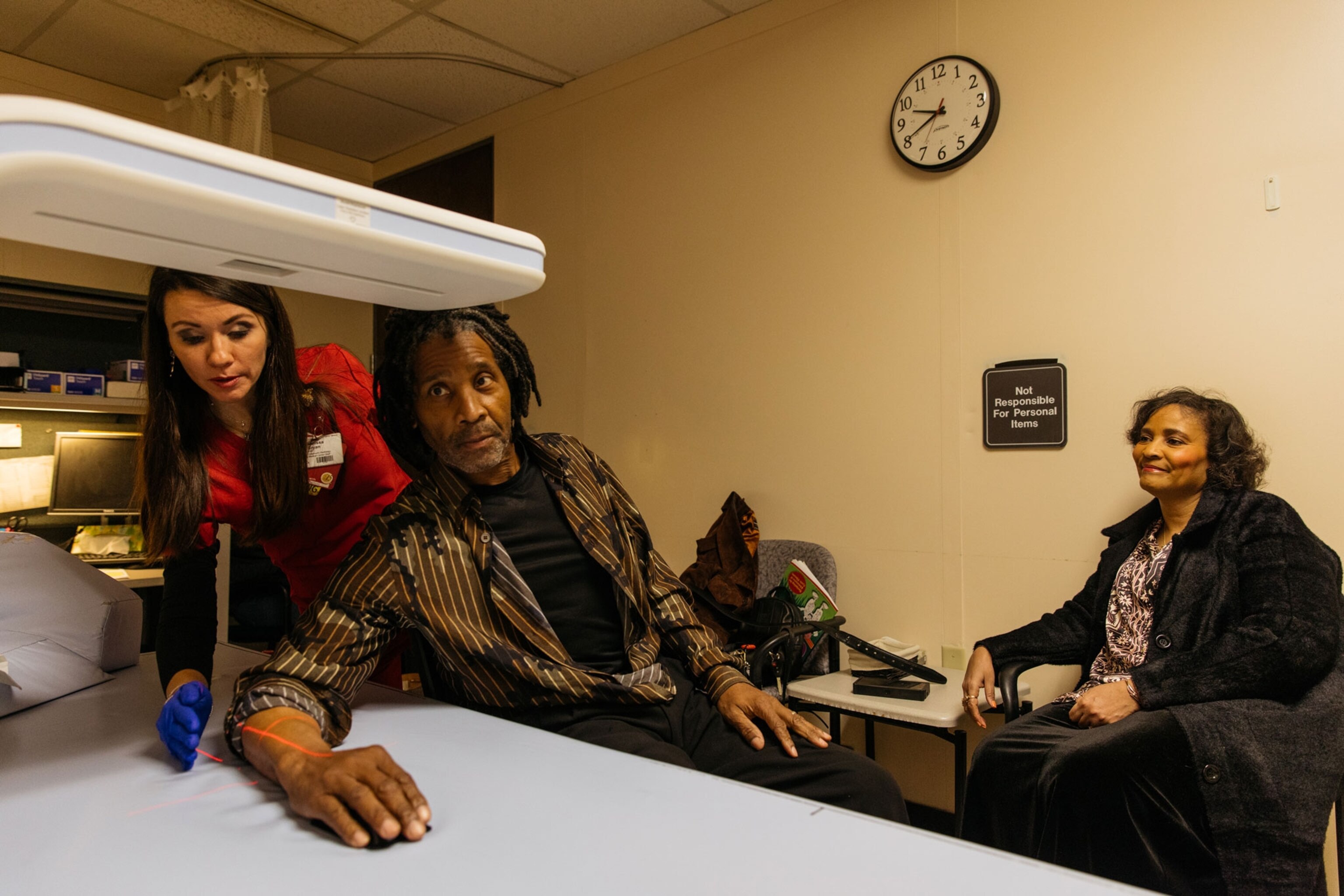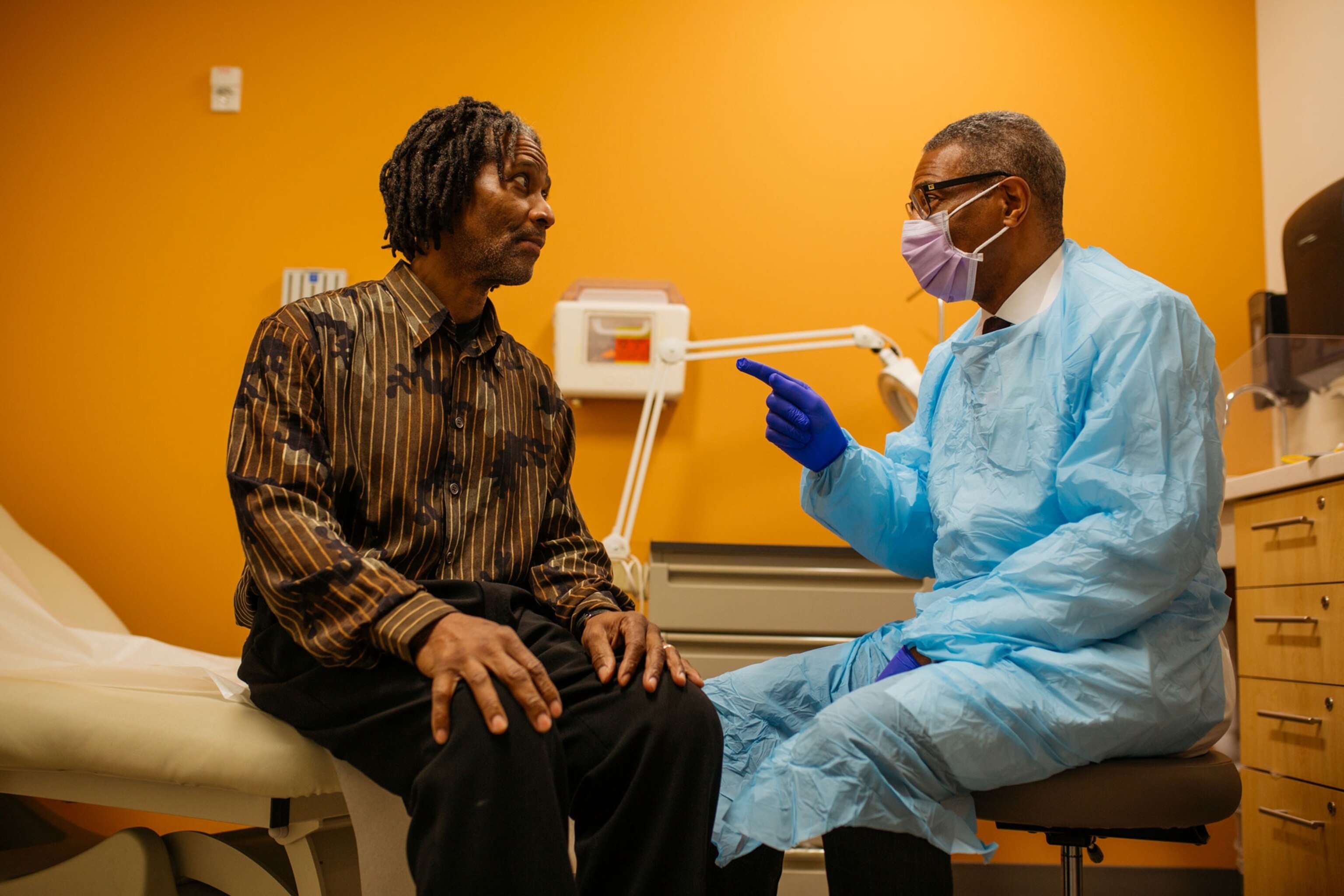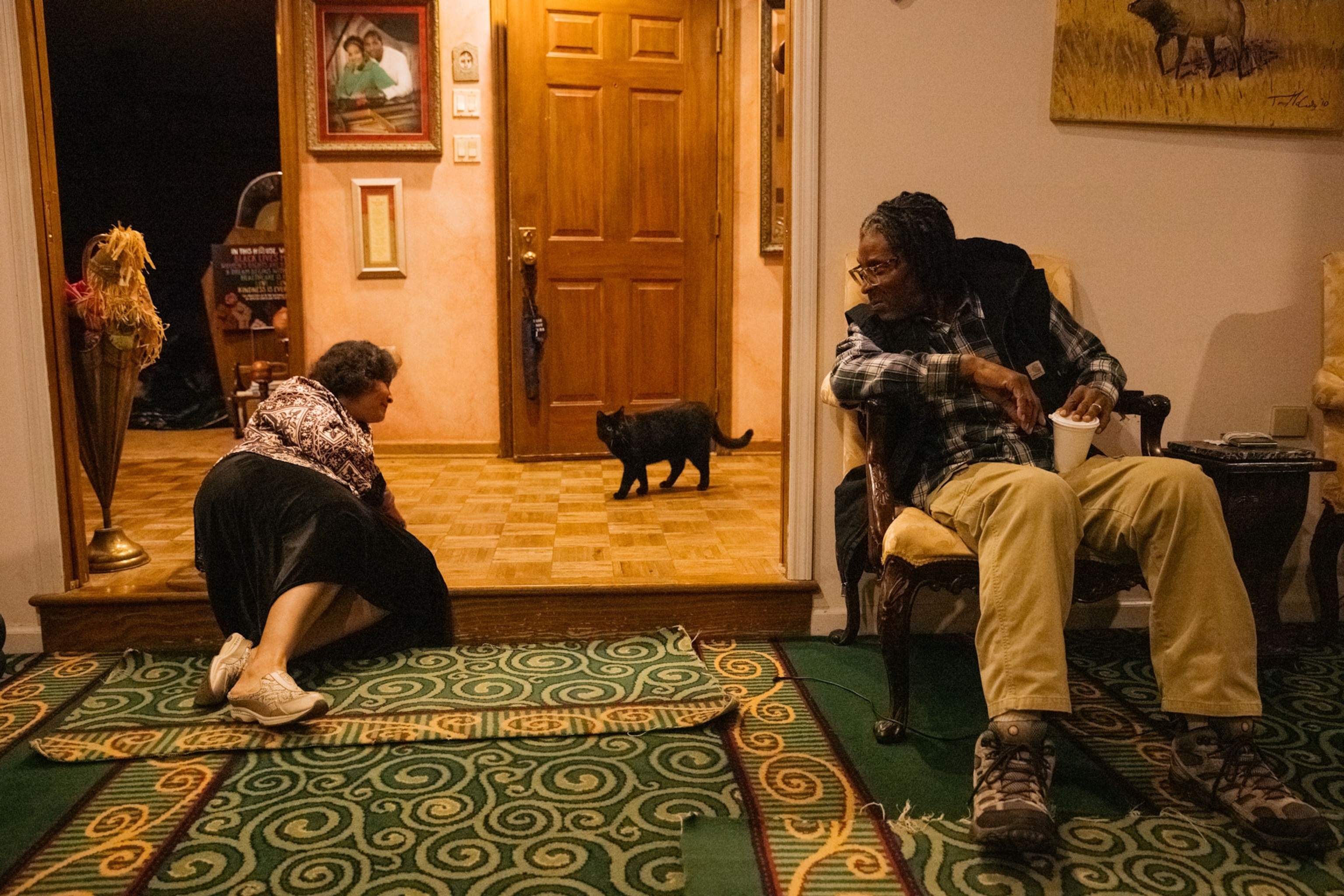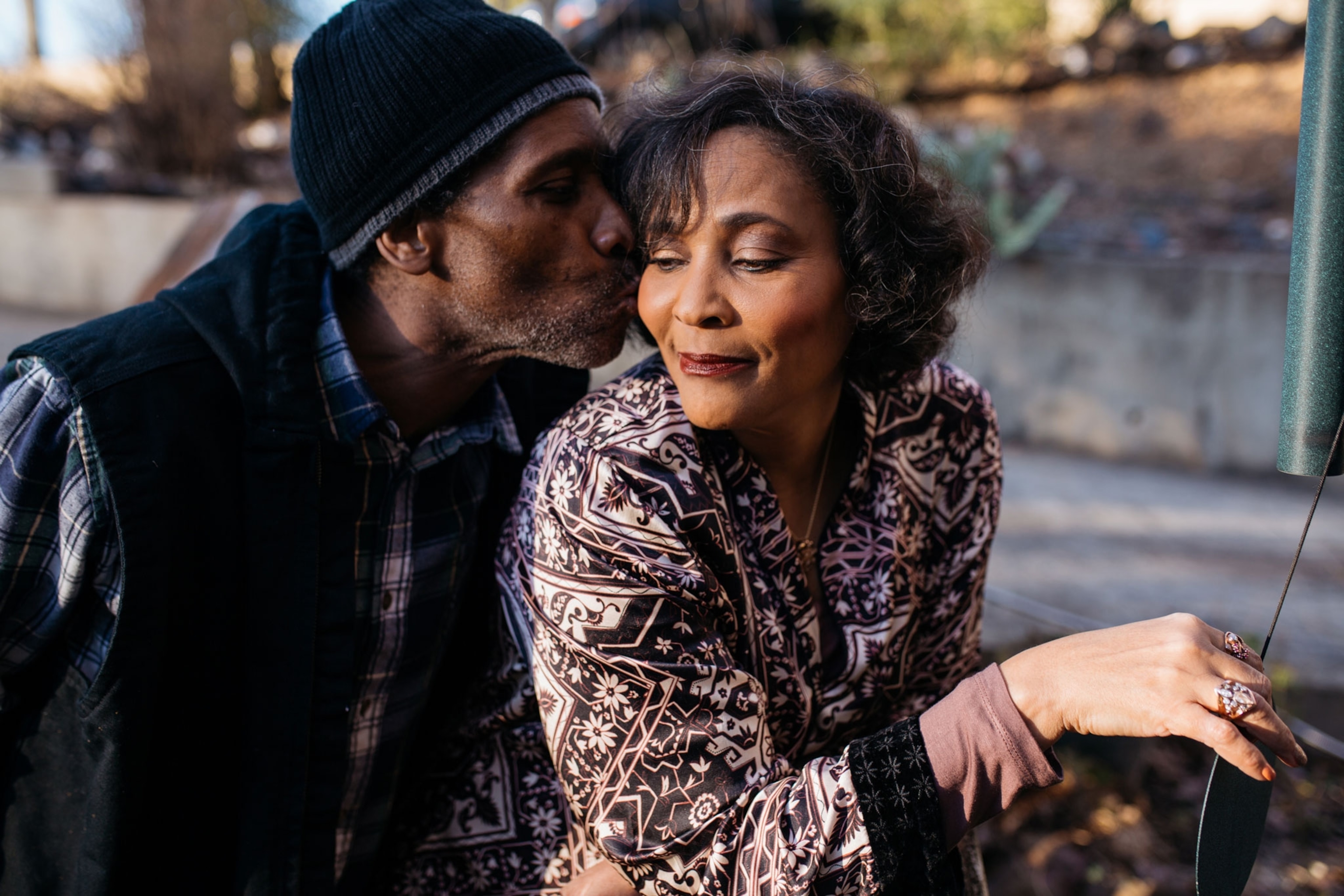This crippling disease often goes under-diagnosed—unless you’re white
Anyone, of any ethnicity, can get cystic fibrosis. But for decades it has been overlooked in people of color, leading to misdiagnoses and dismal health disparities.

Terry Wright spent his childhood in Little Rock, Arkansas, struggling with severe stomach pain. “That initial blow when you first get kicked,” he says, “that was the pain, and it didn't go away.”
He vomited after every meal, and the crippling stomachaches discouraged him from trying to eat or drink more, leading to severe malnutrition. Each trip to the emergency room yielded a different diagnosis—ulcers, a virus, the flu—and then doctors would inject him with painkillers. “That would just kind of hold me for a few hours. And then the pain would start back again,” he says. As he grew up, he had frequent sinus infections, and bronchitis and pneumonia, causing such severe sickness that he spent at least two-and-a-half weeks in the hospital every three months.


Wright, a fitness trainer, prize-winning master gardener, and naturalist, has struggled with these serious health issues his entire life. But he wasn’t diagnosed with cystic fibrosis—a rare, life-threatening genetic disease—until he was 54. He’d come close to being correctly diagnosed in 2000 when he was 38: A doctor told him, “If you were not Black, I would say you had cystic fibrosis.”
Cystic fibrosis (CF) is one of the most common inherited diseases in white Americans—occurring in 1 in every 4,855 births—but mounting evidence suggests that the disease is more common in African Americans, South and East Asians, Hispanics, and Africans than previously recognized. A study published last year in Pediatric Pulmonology revealed that genetic screening of newborns was more likely to fail to detect cystic fibrosis in non-white babies than in white ones, suggesting the tests are poorly designed to identify the disease in people of color. For people with CF, late diagnosis is costly, boosting the risk for irreversible lung damage and other serious health outcomes.
“We found there's huge disparities between babies of different races and ethnicities, and whether they're going to be detected,” says Meghan McGarry, a pediatric pulmonologist at the University of California, San Francisco, who led the study. “Diagnosis really depends on what your race and ethnicity is” she also says. “That's just unethical.”
In addition, McGarry says, many medical professionals are still being incorrectly taught that CF is a white disease.
What is disturbing to physicians who have heard Terry’s story is that he had the classic cystic fibrosis symptoms. “I feel like it's just another bit of evidence for systemic racism,” says Jennifer Taylor-Cousar, professor of internal medicine and pediatrics at National Jewish Health in Denver, Colorado. Taylor-Cousar thinks the physicians “didn't care” about Wright’s case. “It wasn't important to them. And so, they ignored it.”
When people are diagnosed late, “it impacts their health outcomes,” says Taylor-Cousar, who is Black. “It also makes them not trust the medical system, because they are repeatedly told the wrong information.”
Most physicians and many pulmonologists had never examined a cystic fibrosis patient in 2000, the year Wright was misdiagnosed, let alone an adult patient, explains Larry Johnson, Wright’s pulmonologist and director of pulmonology and critical care medicine at the University of Arkansas for Medical Sciences. Johnson, who is also Black, is less inclined to attribute Wright’s dozens of misdiagnoses and treatments to racism. He says that in 2000, cystic fibrosis was considered a rare, pediatric disease because patients died so young, suggesting that may have been why Wright was overlooked.
Why is CF considered a 'white' disease?
Dorothy Andersen, a pathologist based at Babies Hospital in New York, first characterized cystic fibrosis, and published the seminal account in 1938. From the beginning, she recognized the disease could affect anyone—not just white people. “One of the patients of the Babies Hospital was a Negro, and the parents of the others came from Puerto Rico, Italy, Germany, Ireland,” she wrote.
But over the course of the next eight decades, the inherited condition became perceived as a white disease. Taylor-Cousar, who is the adult patient care representative on the Cystic Fibrosis Foundation’s Board of Trustees, suspects that was because the people who founded the foundation in 1955 were a small group of affluent white parents, the doctors were predominantly white, hospitals were still segregated in most places, and “so when the textbooks got written, they got written by the people with the money in the majority,” she says. “There wasn't enough of a voice of people of color to counteract that.”
Because these texts were used in medical schools, it led to the perception that CF was a white disease, “and of course, that perpetuates itself,” leading to health inequities for people of color, says Taylor-Cousar.
Today, the idea that CF is a white disease is a “misperception by those who have not been deeply involved in CF care,” says Mike Boyle, a pulmonologist who led the Johns Hopkins University Adult CF Program for 20 years and is the current CEO of the Cystic Fibrosis Foundation in Bethesda, Maryland. Physicians at Boyle’s CF center cared for many Black and Middle Eastern patients. But, he admits, that was unusual. Most health workers around the country have had limited exposure to CF patients, and those they meet are usually of Caucasian descent. This has led to missed and delayed diagnosis of CF, says Boyle, and contributed significantly to health outcome disparities for people of color.
Why are more white people affected by CF in the United States?
To develop cystic fibrosis, a child must inherit a genetic mutation in the cystic fibrosis transmembrane conductance regulator (CFTR) gene from both parents. Since the gene was discovered in 1989, more than 2,500 mutations have been identified, many of which can alter the structure of the CFTR protein and cause the disease.
Anyone, of any ethnicity, can get this disease. But which mutations a person carries usually depends on ancestry. One in 25 white people in the U.S. whose ancestors came from western Europe carry a mutation in their CFTR gene called F508del—which is believed to have arisen about 5,000 years ago. It is the most common CF-causing mutation in the country.
Currently there are believed to be about 40,000 people with CF in the U.S.—of these 91.4 percent are white, 3.5 percent African American, and 5.1 percent are of other races. But these stats are now being regularly revised as new mutations are identified in people of color.
In other countries where people migrated from western Europe, the F508del mutation is also present, but less common. And mutations that have arisen spontaneously in Egypt, India, or China, for example, are completely different and are not included in routine genetic screening. Children with those genetic mutations are typically diagnosed late and can suffer permanent organ damage with dire consequences.
When Andersen published her description of cystic fibrosis in the early 20th century, the disease could kill a baby before its first birthday—with malnutrition and/or lung infections often the main causes of death. But after she created a diagnostic test, the administration of digestive enzymes extended life expectancy to about 12 years old. In the 1990s, inhaled antibiotics and drugs that help clear deadly mucus from lungs pushed life expectancy into the early 30s.
But in the past 10 years, breakthroughs in drug development have created revolutionary treatments. For those carrying certain mutations, the treatment is so effective that it is essentially a cure. And patients who receive these treatments in infancy are expected to live full lives, perhaps without any symptoms. Newborn screening and testing for all mutations, even the rare ones, is what allows these early life-changing interventions.


Terry’s story
In 1999, Terry Wright met Michele Wise, who founded the National Society of Black Engineers at the University of Tennessee Space Institute but had pivoted to a career in pharmaceutical and biotechnology sales following a tenure as an electrical and industrial engineer. At the time, Terry’s inability to digest food became life threatening. Surgeons performed an operation on his damaged pancreas, rerouting digestive juices so they could reach his gut and enable him to absorb nutrients. But his lung infections got worse. During each hospital stay, doctors treated him with heavy doses of antibiotics and oxygen.
When they married in November 2000, Michele knew she was stepping into the role of wife, caretaker, and advocate. She sensed from Terry’s medical history, and from the frequent visits they made to the emergency room every week, that the doctors were missing critical clues. “It was nothing but pain, suffering, and devastation” for the next 16 years, Michele says.
In 2016, antibiotics failed to vanquish an infection in Terry’s lungs—and he spent Christmas and New Year’s in the hospital. Frustrated and desperate for another perspective, Michele took Terry to the University of Arkansas for Medical Sciences where she sought out an infectious disease specialist. After examining Terry, Keyur Vyas said that his symptoms seemed consistent with those of cystic fibrosis. He ordered the gold-standard diagnostic for the disease: a test that measures the salt concentration in sweat, which is particularly high in people with CF because the CFTR protein in the sweat glands malfunctions and releases too much salt.
Terry tested positive for CF. Twice.
CF newborn screening and health disparities
Since 2010, all 50 states have implemented a two-part newborn screening test for CF. The first part tests for high levels of a chemical called immunoreactive trypsinogen—which is a chemical made by the pancreas. If levels are too high, the baby’s DNA is screened for mutations that could cause cystic fibrosis. When a mutation is identified, early interventions that improve nutrition and lung health can save lives.
But as Meghan McGarry’s study showed, the types of genetic mutations used to diagnose CF vary from state to state and have dramatically different impacts on detection of CF in various ethnic groups.
In Mississippi, the tests only screen newborn DNA for the most common CF-causing mutation in the Caucasian population: F508del. As a result, the state detected only 53.7 percent of African American babies that had the disease; 64 percent of Native Americans and Alaskans; 42 percent of Asians; and 66 percent of Hispanic patients. It identified 87.5 percent of white babies with CF.
Even states that used more comprehensive genetic tests, which screened for 139 mutations, were not infallible. They detected only 83.4 percent of African Americans babies with CF; 91 percent of Native Americans and Alaskans; 90 percent of Hispanics; and 72.4 percent of Asians. But the tests found 96.7 percent of CF cases in white people.
“But they didn’t look at all the mutations,” says Taylor-Cousar, “because we weren't acknowledging that disease existed in other people.”
Diagnosed through IVF
That was the case when a pulmonologist in Portland wrote in Sowmya Bobba’s medical chart that he suspected she had cystic fibrosis but wasn’t going to test her for it “because she was of an Asian race.” Bobba, who moved from Vijayvada, India, in 2013, had always suffered from coughs and colds but had never been treated with anything other than antibiotics, inhalers, and some steroids.
In 2018, after Bobba and her husband had been trying to conceive for a couple of years, she had a genetic test done as a standard part of an in vitro fertilization procedure. The tests revealed her ovaries were healthy and her husband’s sperm count was good. But the doctor who authorized the tests called her and asked, “Did you know you have cystic fibrosis?”
“I had a lot of mixed reactions,” Bobba says. “I was very happy that I was diagnosed and knew that, OK, something was wrong with me.” But it also made her feel vulnerable and scared, paranoid of getting sick and fearful of dying young.
In 2020, Bobba set up an appointment with Aaron Trimble, who directs the adult cystic fibrosis center at Oregon Health & Science University. There, a team of experts schooled her in nutrition, the hours-long nebulizer treatments, physical therapy she would need to do daily at home to keep her lungs healthy, and all the other aspects of living with the disease.
“The adults who lived like Sowmya for 30 years with symptoms…are the ones who tend to get overlooked,” Trimble says. “They were just sick enough to go to a doctor, get some antibiotics, get an inhaler, get something, get sort of better, and just get passed along.”
The drug Trikafta had been approved in 2019 for patients who carried the F508del mutation—the one that is most common in the U.S., not the one Bobba has. But the drug maker Vertex Pharmaceuticals kept testing the drug on cells with less common mutations, one by one, to see whether it would work for those.
In 2021, Trimble delivered good news. The U.S. Food and Drug Administration said the drug could also treat Bobba’s rare mutation. He encouraged her to delay IVF treatments because he knew that women with CF-related infertility had conceived naturally after taking the drug.
Bobba began taking Trikafta—just a single pill every day—beginning in November 2021. By early February 2022, she was pregnant. In October 2022, she gave birth to a healthy girl and is feeling great. With Trikafta she is freed from the hours spent doing breathing treatments.
These days when Trimble is working with medical students or with residents in the intensive care unit, he’ll ask them to share what they know about CF. Most know that cystic fibrosis causes chronic lung disease and limits lifespan. They know that the F508del mutation is the most common. “Most will say it is more common in people who are white or of European descent,” says Trimble.
When he asks how common that mutation is in white people, only a few are aware that one in every 25 Caucasians carry it. But when Trimble asks about non-whites, “Nobody has any idea.”

CF in other countries
This disease affects people from every ethnic background, says Samya Nasr, a pediatrician and director of the Cystic Fibrosis Center at the University of Michigan. The incidence might be lower in other countries and among people of non-European ancestry, but statistics on its frequency are spotty or nonexistent because the mutations have not been identified and genetic testing isn’t common. “In the U.S., we see it in African Americans, we see it in Hispanics, we see it in Chinese Americans, Japanese Americans … Asian Indians. So it’s everywhere.” And that includes Egypt.
When Nasr attended Ain Shams College of Medicine in Egypt, she was taught that CF didn’t occur in the country. “But that was false. Because really, if you don’t test for something, you’re not going to find it.”
In the early 2000s, Nasr began collaborating with faculty at Cairo University’s pulmonary and gastrointestinal clinic. They began testing the saltiness of patients’ sweat with equipment donated by a company in the U.S., and they found that 12 of the 60 patients they tested carried the disease.
When the results were published, Cairo University invested in their own testing equipment and began diagnosing patients. So far, between 800 and 1,000 people have been diagnosed with cystic fibrosis, Nasr says. Since Nasr was able to arrange donations of sweat testing equipment to several universities in Egypt in 2021, the number of new patients has escalated.
But without access to digestive enzymes to help children with nutrition and treatments to clear their lungs, survival for CF patients is about eight years in Egypt; in the U.S., it’s now 53.
Nasr has teamed up with the Michigan-based Bonnell Foundation to get medicines and chest-clearing equipment donated to Egyptian patients, and to spread the word that people of color can get CF.
Going forward
After he was diagnosed in 2017, Terry Wright, with his wife Michele, founded the National Organization of African Americans with Cystic Fibrosis (NOAACF) to raise awareness of the disease among African Americans.
In 2021, Trikafta was shown to be effective for Terry’s mutation, and he began taking it immediately. Even though his health was improving, he was keen to make sure that others didn’t repeat his medical odyssey. Working with Taylor-Cousar, the Wrights created a free screening tool to help Black, Indigenous, and other people of color, or their medical providers, determine whether they have symptoms that match CF.
Boyle, the Cystic Fibrosis Foundation’s CEO, says the group is working with state health officials to explain the importance of expanding newborn screening to include a broader range of mutations that cause CF. The foundation is also addressing health inequities by independently testing cells carrying rare CF-causing mutations to find ones that may respond to Trikafta so more people of color may benefit.
Lathronia Jefferson, whose 12-year-old son Khaleb has CF, has had her share of run-ins at the ER when doctors have asked her whether she is sure that her son has CF. But her frustrating experiences have motivated her to work with the Cystic Fibrosis Foundation to educate medical providers.
“If I'm having this much trouble, and my child is only 50 percent African American, what about someone who is 100 percent and has this disease? How are they dealing?” Now when someone says to her that CF is rare in African Americans or people of color she says: “It's just underdiagnosed in people of color. The light has just not been shone on the fact this is not just an Anglo-Saxon disease. People of color have this.”








